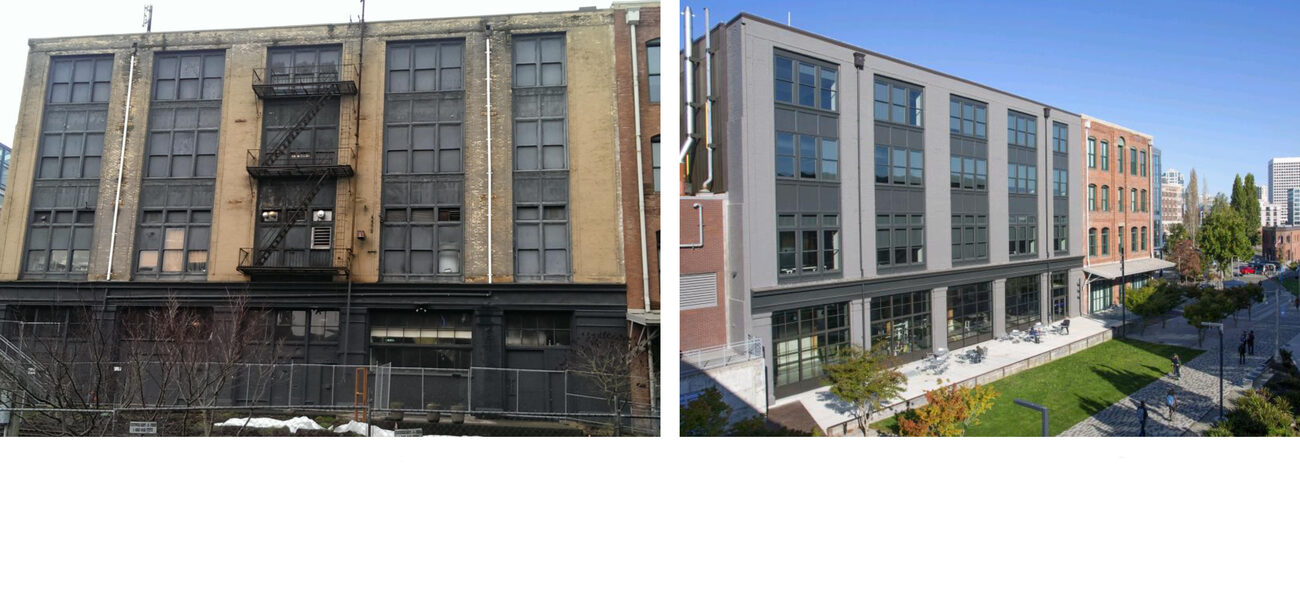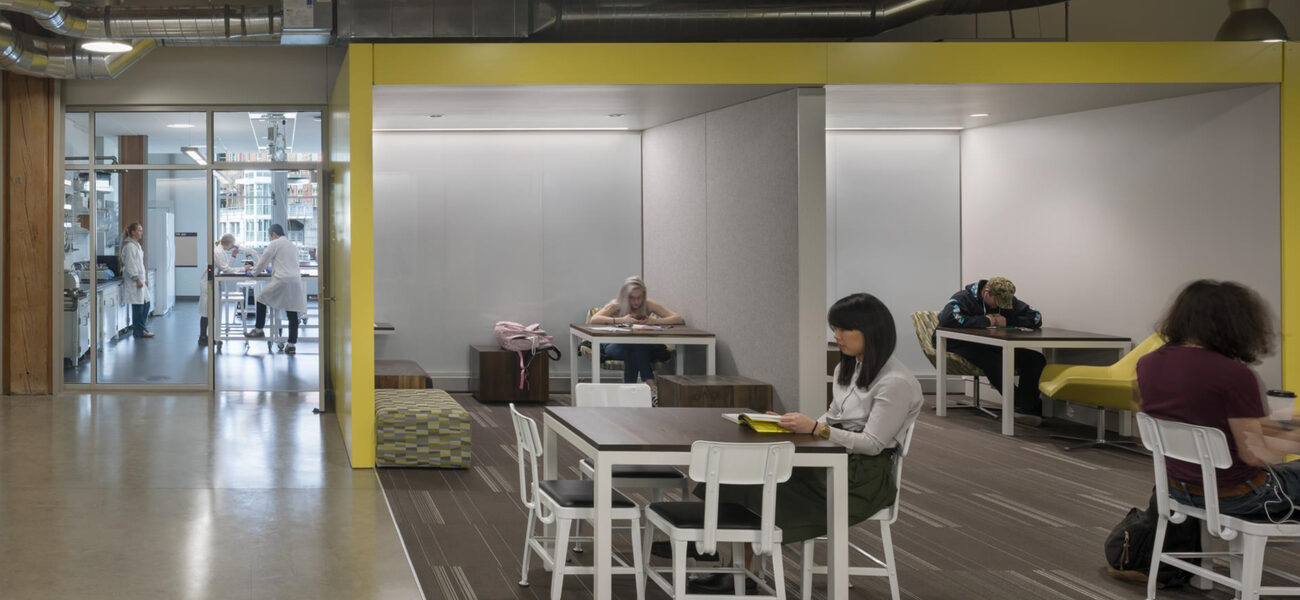When the small, commuter-focused University of Washington campus in downtown Tacoma decided to renovate the old Tacoma Paper and Stationery building, the idea wasn’t just to create a biomedical research lab, or an electrical engineering facility, or an urban studies center, or a community meeting place, or maker space. The goal was to accomplish all of those things in one facility, and to serve as a home away from home for students, faculty, and the greater Tacoma community, in spaces that were welcoming, informal, and multi-functional. Some of the biomed labs and classrooms have glass walls; many rooms have movable furniture and adaptable designs; and shared spaces allow individuals or groups to just pop in without reserving them in advance.
“Instead of making a discipline-specific building, the University chose to take little pieces from other programs,” says Elizabeth Moggio, architect and associate at the Miller Hull Partnership in Seattle. “Out of the Life Sciences program was emerging a biomedical emphasis. Out of the Institute of Technology was a need to have electrical engineering labs and a larger electrical engineering program. The Urban Studies program was trying to start an urban design major. So, finding all these new programs and bringing them together in this building was a way they could ensure that more people could connect, instead of just science students or architecture students who spend their entire undergraduate life in one discipline-specific building.”
The multi-function requirements for the 40,000-sf structure—built in 1911 and used most recently as an Old Spaghetti Factory restaurant—made the renovation far more complex than a single-use project. But it also created opportunities. In keeping with the mixed-use concept, the academic programs are not segregated on different floors of the three-story building: Biomed labs, engineering labs, team spaces, and active learning classrooms are mingled on the second and third floors. Urban design studios, community studios, and a community meeting room are located on the first floor. And a maker space, a student living room, and additional team spaces are on the ground floor.
The building also has plenty of natural light, clear wayfinding, wide stairways, and excellent sightlines, so that people can not only find their way around, but also feel welcomed. “You can make spaces, but if it’s not very intuitive how to find them and that people are supposed to use them, they won’t get used. If they have to ask permission, if there is some unseen barrier that you provided that you weren’t aware of, it makes it really hard for people to feel like they are at home,” says Moggio.
The Urban Solutions Center, which opened in the fall of 2018, has become a magnet that attracts and engages students, faculty, and community members with its varied components, says Jeannie Natta, project manager, major projects, for the University of Washington:
Informal Learning Spaces: The fact that UW Tacoma is predominantly a commuter school has several implications. First, when students have a break between classes, they can’t go back home or to a dorm room, so they need comfortable areas to just hang out and relax, charge their phone, have a snack, and check email. Students also need space that is a little more professional and has more of an office feeling.
Most learning takes place outside of the classroom, with students working together in groups, networking, and making connections in an unstructured, informal manner, with access to their professors. But faculty don’t have offices in this building, so it also needed to include spaces for faculty and students to meet.
The solution was to create many different types of spaces, from a designated student living room on the ground floor; a more professional community meeting room on the first floor; and informal nooks and crannies on the second and third floors, where people can sit quietly or meet with their peers.
For example, seminar rooms, which are also used by community groups during the evening, are paired with open areas featuring soft furniture, so people can break out of a seminar into smaller groups. There are also small nodes scattered along the wide corridors, some featuring whiteboards, so students can meet with a faculty member or just relax between classes.
Student Living Room: On the ground level is a student living room stocked with soft furnishings, big tables, and stools on wheels, so that people can move them around. The student living room, which was designed to feel homey, informal, and relaxing, opens to an outdoor café through large hydraulic lift doors.
Maker Space: There was a strong demand for maker space on campus. The urban design teams wanted an area where they could build large-scale models. And both the biomed and engineering faculty thought it would be a great idea to have a place where students new to these programs could get their first hands-on exposure to equipment like microscopes, oscilloscopes, and circuit boards. And there was a need for places where students could just tinker. The result is what Moggio calls a “nice warm shell,” a space that has movable furniture made from timbers that were removed during the renovation process, sinks, movable whiteboards, projectors, and plenty of power sources. At this point, the school is still working out the details of how the space will be used, says Natta.
Community Space: On the first floor, there’s a community space that’s designed to be more professional. It also serves as a front parlor, providing a welcoming entrance for visitors. The space can also be combined with the student living room and maker space on the ground floor to create a multi-level area to host events like job fairs and alumni and donor events.
Urban Design Studio: The school wanted to expand its urban studies program and build stronger connections with the city of Tacoma and the vibrant downtown business community surrounding the campus. So, the urban design studio was placed on the first-floor level, which feeds out onto Jefferson Avenue, a main artery in the city. An early opportunity for collaboration arose when the city needed technical assistance with a GIS data mapping project.
Biomedical Labs: At most schools, faculty members are assigned to a particular lab which they consider their own, says Moggio. Here, the biomed wet labs contain shared spaces at either end of the room. And it’s not uncommon to see an expert from the local community, who might be helping out on a research project, working with students and faculty in the lab.
But it was difficult repurposing an old factory into a modern lab. “We were given a timber-framed structure that wouldn’t hold a lot of vibration-sensitive equipment,” says Moggio. “It did, however, have some great bones where we were able to put in lots of water, gas, and hoods.”
Classrooms/Labs: One of the targets of the renovation was to set up the building to last another 50 years. No one can anticipate the types of classroom or lab requirements that might be needed in the future, so the spaces are designed for flexibility and adaptability. The power delivery comes from cord reels located in the ceiling, where there’s space to accommodate additional mechanical equipment, if needed. The rooms have features that can be used for a variety of disciplines, such as pinup surfaces, writable surfaces, and AV cabinets in the walls. And the furniture and chairs are moveable.
Community Connection: Since most of the students find jobs in the Tacoma region, it’s important to build connections with the business community. The signage and graphics used in the renovation connect not to the specific disciplines or programs, but back to the history of the region. For example, a “Tacoma Paper and Stationery” sign greets people as they enter the building. Business donors to the school are recognized in the form of a donor wall made of wood blocks carved from timbers taken from the building during the renovation.
The multi-use approach is particularly applicable at smaller schools, where an emerging or expanding program might not require an entire building, says Moggio. The idea of mixing different academic programs in one facility allows the school to do much more than just give the programs a home. It gives the entire campus a new home and leads to some unexpected results: A couple recently held their wedding there.
By Neal Weinberg

